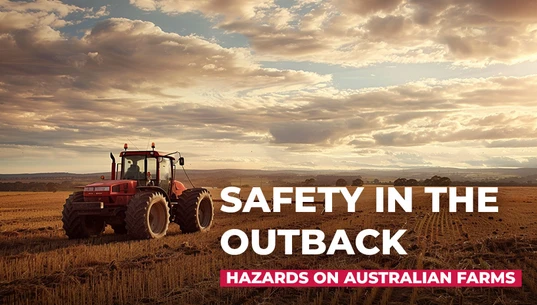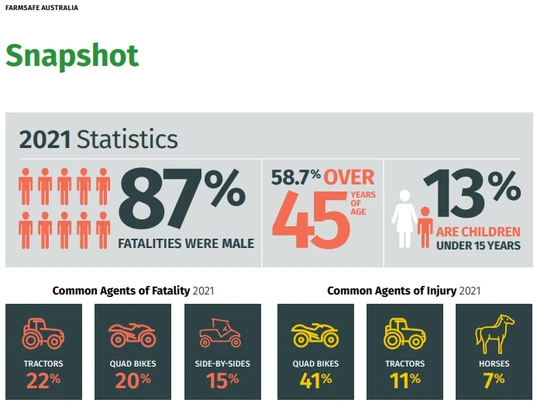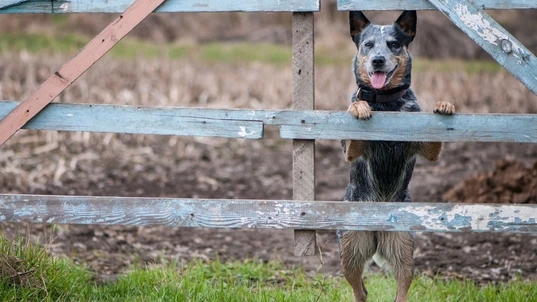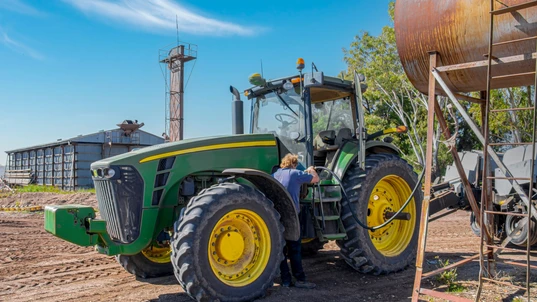Hazards on Australian Farms

Danger
 Farming is the backbone of Australia. Providing our population with the food and textiles we need, the role that farm workers play is a vital one.
But farming is a uniquely dangerous occupation. The array of injuries sustained is vast, and risks and hazards on Australian farms can arise from:
Farming is the backbone of Australia. Providing our population with the food and textiles we need, the role that farm workers play is a vital one.
But farming is a uniquely dangerous occupation. The array of injuries sustained is vast, and risks and hazards on Australian farms can arise from:
- Geographical isolation
- Solitary work
- Equipment and vehicles
- Chemicals
- Animals
- Noise
- Working outdoors
- Dust
Statistics
Farming is one of the most dangerous occupations in Australia. According to Better Health farming has about 8 times the rate of fatality of the general employed population. An average of 52 farmers were killed in work-related incidences per year for the past 20 years. Vehicles made up about 39% of major injuries, and machinery accounted for about 26%. Just over half of all work-related farming incidences involved workers over 55 years of age.
Farmsafe Australia statistics of farm injuries and fatalities in 2022.
Equipment and Vehicles
With the advance of technology, farms are using more machinery and vehicles than ever before. This in turn leads to an increase in hazards. Equipment and vehicles account for the majority of injuries and deaths on Australian farms, with some common incidences being:- Crush injuries
- Lacerations
- Broken bones
- Concussion
- Eye damage
- Internal organ damage
- Amputation
- Falls
Chemicals
As the saying goes, the dose makes the poison. Everything is a chemical, but the dose of that chemical is what can make it dangerous. Farm workers are often dealing with very large quantities of hazardous substances such as cleaning products, herbicides, pesticides, fertilisers, process-specific chemicals, and even water. Exposure to some of these substances, over a short or prolonged period, can lead to:- Headache
- Skin irritation including dermatitis
- Irritation of the respiratory system
- Nausea and vomiting
- Chemical burns
- Nervous system disorders
- Poisoning
- Birth defects
- Lung, liver or kidney disorders

Animals
Farm animals can pose a range of significant hazards for farm workers. Their size, strength, and unpredictability are often overlooked due to the need for speedy processing. When working with animals, farmers are at risk of:- Being crushed, gored or trampled
- Bites, lacerations, bruises
- Broken bones
- Internal organ damage
- Blunt force trauma
- Falls from riding
- Dislocations
- Needlestick injuries during animal vaccinations
- Degenerative joint and muscle damage
Noise
Big machinery brings big noise. Large numbers of livestock also bring big noise. Even strong and steady winds bring big noise. All of this noise can permanently damage workers’ hearing. Occupational hearing loss is an often-overlooked hazard, and as such it is important to be vigilant about noise levels in each work area.Dust
Farm workers can be exposed to dust through many different sources:- Weed/pest control
- Mouldy areas
- Dry land
- Transporting grain and livestock
- Harvesting
- In the stockyard
Working Outdoors
Working outdoors can be an incredibly rewarding experience. Constant fresh air is a blessing, but constant exposure to the elements can be very damaging. Sun exposure increases the risk of skin cancers, and wind can damage skin, eyes, and ears. Extreme temperatures pose their own hazards, with heat exhaustion common in outback Australia. On the other hand, exposure to freezing temperatures brings a risk of frostbite and hypothermia.
Encourage your fellow farmers to embed safe working practices.
Making the Farm Safer
Farms can be safe places to work, as long as care is taken to follow the appropriate regulations. Personal protective equipment should be provided to mitigate hazards across each are of the farm. Examples include:- Earphones or other hearing protection
- Gloves
- Shoe covers
- Overalls
- Protective suits
- Breathing masks
- Adequate ventilation
- Sun protection
- Goggles
First Aid Training is Critical for Farm Workers
Farmsafe Australia has identified complacency as a real and persistent hazard on Australian farms. Workers can become complacent over time, and this increases the risk of injury or death. Ensuring your first aid training is up to date is one way to combat complacency and puts you in a position of power to help those on your farm (including yourself) when an injury occurs. Adequate first aid training can mean the difference between life and death on Australian farms.
Originally published at
https://www.australiawidefirstaid.com.au/resources/hazards-on-australian-farms
as part of the Australia Wide First Aid Articles Library









